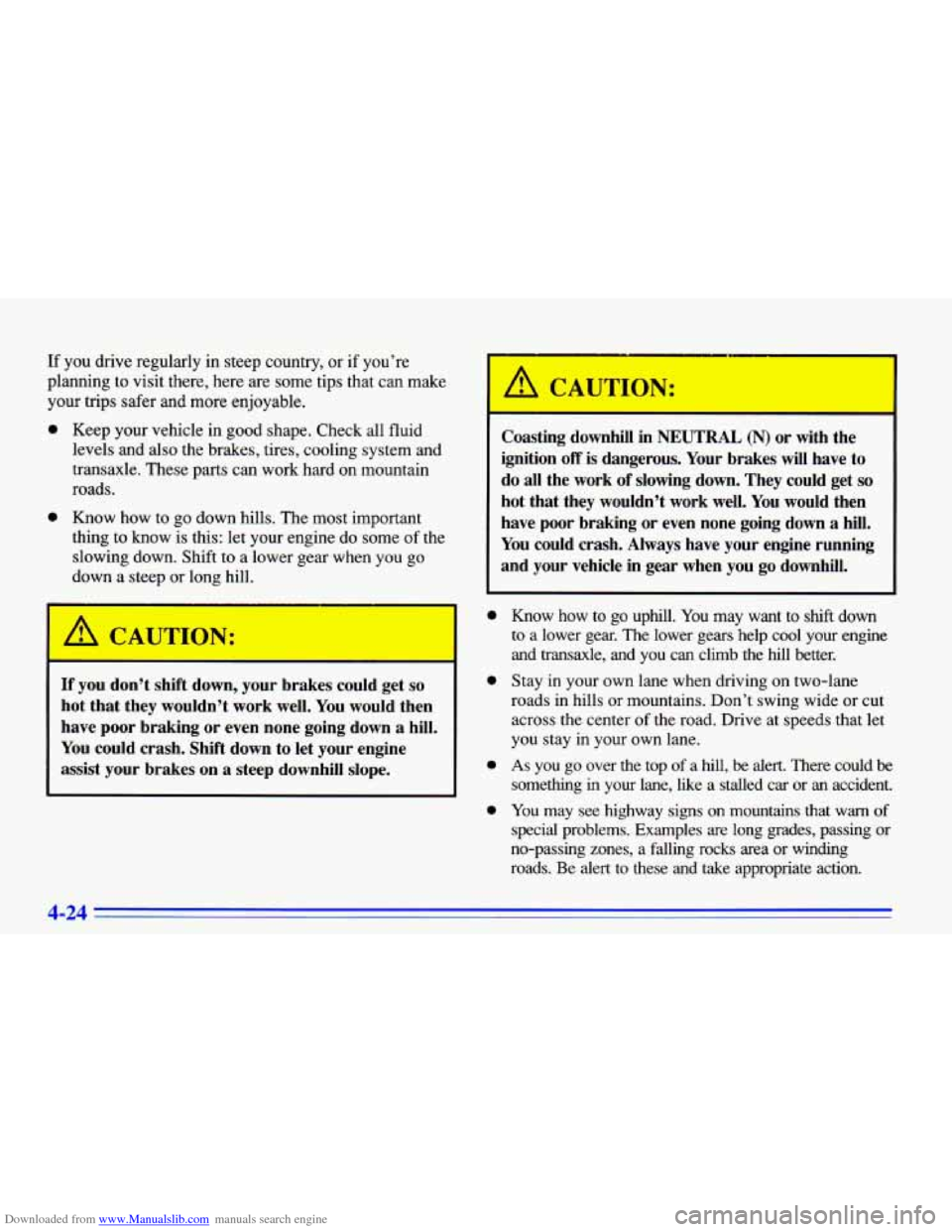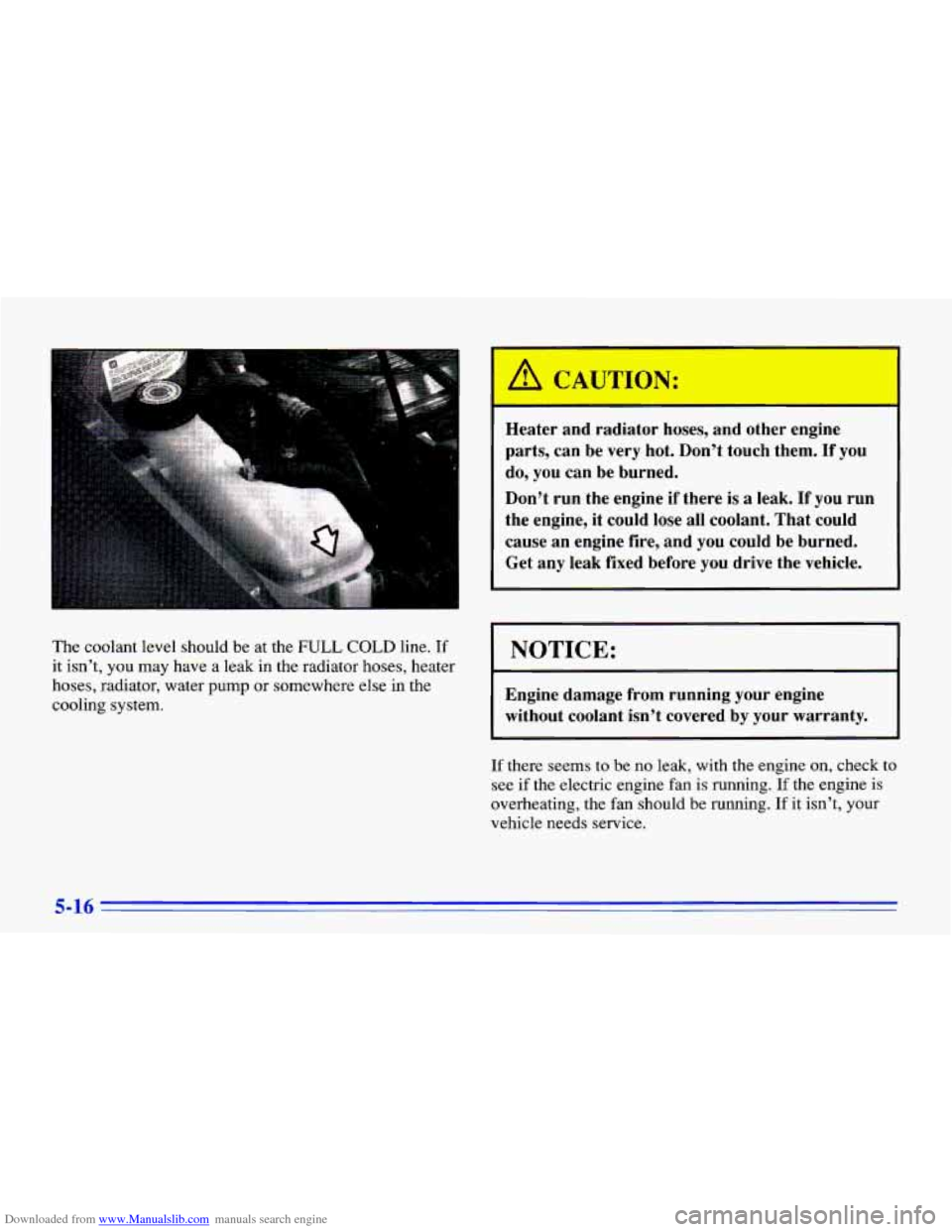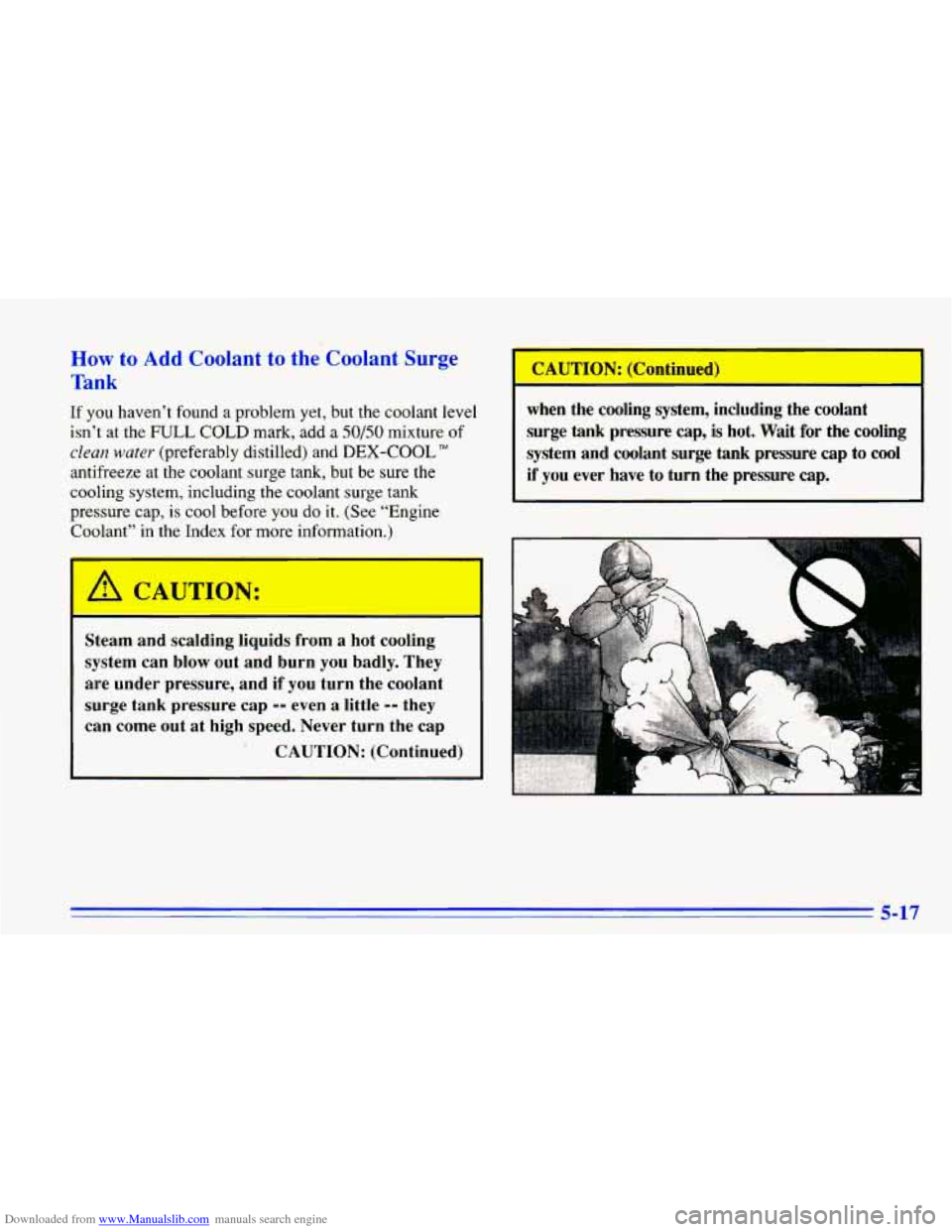1996 CHEVROLET CAVALIER cooling
[x] Cancel search: coolingPage 65 of 372

Downloaded from www.Manualslib.com manuals search engine Replacing the Batteries in the Keyless Entry System
Transmitter
1. Pop the cover off by inserting a coin or similar object
in the slot between the covers,
and then twisting.
2. Lift the cover off, bottom half first
3. Remove and replace the two batteries. Use two
Duracell@ batteries, type
DL-2016, or equivalent.
4. Put the two halves back together. Make sure the
cover
is on tightly, so water won’t get in.
5. Check the transmitter operation.
Trunk
It can be dangerous to drive with the trunk lid
open because carbon monoxide (CO) gas can
come into your vehicle. You can’t see or smell
CO. It can cause unconsciousness and even death.
If you must drive with the trunk lid open or if
electrical wiring or other cable connections must
pass through the seal between the body and the
trunk
lid:
Make sure all windows are shut.
Turn the fan on your heating or cooling
system to its highest speed with the setting
on any airflow selection except
MAX. That
will force outside air into your vehicle. See
“Comfort Controls” in the Index.
If you have air outlets on or under the
instrument panel, open them
all the way.
See “Engine Exhaust” in the Index.
2-7
Page 140 of 372

Downloaded from www.Manualslib.com manuals search engine '!! FLOOR: This setting sends most of the air through
the ducts near the floor.
The rest comes out of the
defroster and side window vents.
9 DEFOG: This setting allows half of the air to go
to the floor ducts and half to the defroster and side
window vents.
9 DEFROST This setting directs most of the air
through the defroster and side window vents. Some of
the air goes to the floor ducts. The air conditioning
compressor will run automatically in this setting when it
is needed
to help dry the air in the vehicle.
Air Conditioning Compressor Button
Press the A/C button to operate the air conditioner
compressor. The indicator light above the button
will glow when the button is pressed. You don't have
to press the button to run the compressor in
MAX
or DEFROST.
Air Conditioning (Option)
On very hot days, open the windows long enough to
let hot, inside air escape. This reduces the time it
takes for your vehicle to cool down, which should
help fuel economy.
For quick cool-down on very hot days, use
MAX with
the temperature knob all the way in the blue area. If this
setting is used for long periods
of time, the air in your
vehicle may become too dry.
For normal cooling on hot days, use
VENT with the
temperature knob
in the blue area and the A/C button
pushed in. The system will bring in outside
air and cool it.
On cool, but sunny days,
the sun may warm your upper
body, but your lower body may not be warm enough.
You can use
BI-LEVEL with the temperature knob in
the middle and the
A/C button pushed in. The system
will bring in outside air and direct slightly warmer air
to
your lower body. You may notice this temperature
difference more at some times than others.
3-4
Page 141 of 372

Downloaded from www.Manualslib.com manuals search engine Heating
On cold days, use FLOOR with the temperature knob all
the way in the red area. The system will bring in outside
air, heat it and send it to the floor ducts.
Your vehicle has heat ducts that are directed toward
the rear seat. Keep the area under the front seats clear
of obstructions so the heated air can reach the rear
seat passengers.
If your vehicle has an engine coolant heater, you can use
it
to help your system provide warm air faster when it’s
cold outside
(0°F (-18°C) or lower). An engine coolant
heater warms the coolant your engine and heating
system
use to provide heat. See “Engine Coolant
Heater’’ in the Index.
Ventilation System
For mild outside temperatures when little heating or
cooling
is needed, use VENT to direct outside air through
your vehicle. Your vehicle
also has the flow-through
ventilation system described later in this section.
Your vehicle’s flow-through ventilation system supplies
outside air into
the vehicle when it is moving. Outside
air will also enter the vehicle when the air conditioning
fan
is running.
3-5
Page 186 of 372

Downloaded from www.Manualslib.com manuals search engine If you drive regularly in steep country, or if you’re
planning to visit there, here are some tips that can make
your trips safer and
more enjoyable.
0 Keep your vehicle in good shape. Check all fluid
levels and also the brakes, tires, cooling system and
transaxle. These parts can work hard on mountain
roads.
0 Know how to go down hills. The most important
thing to know is this: let your engine do some
of the
slowing down. Shift to a lower gear when you go
down
a steep or long hill.
If you don’t
shift down, your brakes could get so
hot that they wouldn’t work well. You would then
have poor braking or even none going down
a hill.
You could crash. Shift down to let your engine
assist your brakes
on a steep downhill slope.
I
Coasting downhill in NEUTRAL (N) or with the
ignition off is dangerous. Your brakes will have to
do all the work of slowing down. They could get so
hot that they wouldn’t work well. You would then
have poor braking or even none going down
a hill.
You could crash. Always have your engine running
and your vehicle in gear when
you go downhill.
0
0
e
e
Know how to go uphill. You may want to shift down
to a lower gear. The lower gears help cool your engine
and transaxle, and you can climb the hill better.
Stay in your own lane when driving on two-lane
roads in hills
or mountains. Don’t swing wide or cut
across the center
of the road. Drive at speeds that let
you stay in your own lane.
As you go over the top of a hill, be alert. There could be
something in your lane, like a stalled car or an accident.
You may see highway signs on mountains that warn of
special problems. Examples are long grades, passing or
no-passing zones, a falling rocks area or winding
roads. Be alert to these and take appropriate action.
4-24
Page 202 of 372

Downloaded from www.Manualslib.com manuals search engine When You Are Ready to Leave After
Parking on
a Hill
1. Apply your regular brakes and hold the pedal down
while you:
Start your engine;
Shift into a gear; and
0 Release the parking brake.
2. Let up on the brake pedal.
3. Drive slowly until the trailer is clear of the chocks.
4. Stop and have someone pick up and store the chocks.
Maintenance When Trailer Towing
Your vehicle will need service more often when you’re
pulling a trailer.
See the Maintenance Schedule for more
on
this. Things that are especially important in trailer
operation are automatic transaxle fluid (don’t overfill),
engine
oil, belt, cooling system and brake adjustment.
Each of these is covered
in this manual, and the Index will
help you find them quickly. If you’re trailering, it’s a good
idea to review these sections before you
start your trip.
Check periodically to see that all hitch nuts and bolts
are tight.
Towing A Trailer (Except Models
with 2.4L Engine and 4-Speed
Automatic Transaxle)
Do not tow a trailer with a Cavalier if your vehicle is:
0 a convertible model.
equipped with a 2.2L (Code 4) engine.
equipped with a manual transaxle or a three-speed
Your Cavalier is neither designed nor intended to
tow
a trailer.
automatic transaxle.
4-40
Page 220 of 372

Downloaded from www.Manualslib.com manuals search engine The coolant level should be at the FULL COLD line. If
it isn’t, you may have a leak in the radiator hoses, heater
hoses, radiator, water pump
or somewhere else in the
cooling system.
’ A C * UTION:
-- I
Heater and radiator hoses, and other engine
parts, can be very hot. Don’t touch them. If you
do, you can be burned.
Don’t run the engine
if there is a leak. If you run
the engine, it could lose all coolant. That could
cause an engine fire, and you could be burned.
Get any leak fixed before you drive the vehicle.
I NOTICE:
r
~~ ~
Engine damage from running your engine
without coolant isn’t covered by your warranty.
If there seems to be no leak, with the engine on, check to
see if the electric engine fan is running.
If the engine is
overheating, the fan should be running. If it isn’t, your
vehicle needs service.
Page 221 of 372

Downloaded from www.Manualslib.com manuals search engine How to Add Coolant to the Coolant Surge
Tank
If you haven’t found a problem yet, but the coolant level
isn’t at the
FULL COLD mark, add a 50/50 mixture of
clean water (preferably distilled) and DEX-COOL TM
antifreeze at the coolant surge tank, but be sure the
cooling system, including the coolant surge tank
pressure cap,
is cool before you do it. (See “Engine
Coolant”
in the Index for more information.)
I A CAUTION:
-
Steam and scalding liquids from a hot cooling
system can blow out and burn you badly. They
are under pressure, and if you turn the coolant
surge tank pressure cap
-- even a little -- they
can come out at high speed. Never turn the cap
’ CAUTION: (Continued) when
the cooling system, including the coolant
surge
tank pressure cap, is hot. Wait for the cooling
system and coolant surge tank pressure cap to cool
if you ever have to turn the pressure cap.
5-17
Page 222 of 372

Downloaded from www.Manualslib.com manuals search engine A CAUTION:
Adding only plain water to your cooling system
can be dangerous. Plain water,
or some other
liquid like alcohol, can boil before the proper
coolant mix will. Your vehicle's coolant warning
system is set
for the proper coolant mix. With
plain water or the wrong mix, your engine could
get
too hot but you wouldn't get the overheat
warning. Your engine could catch
fire and you or
others could be burned.
Use a 50/50 mix of clean
water and
DEX-COOL TM antifreeze.
I NOTICE:
In cold weather, water can freeze and crack the
engine, radiator, heater core and other parts.
So
use the recommended coolant. You
can be burned if you spill coolant
01 lot
engine parts. Coolant contains ethylene glycol
and it will burn if the engine parts are hot
enough. Don't spill coolant on
a hot engine.
1. You can remove the coolant surge tank pressure cap
when the cooling system, including the
coolant surge
5-18